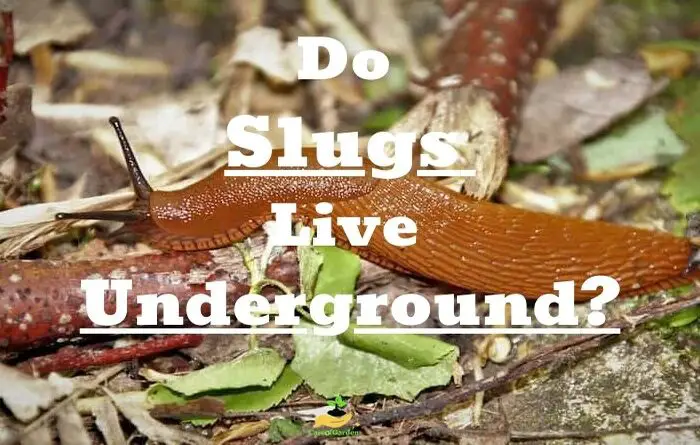Do Slugs live Underground? (Here is the Answer)
Today we are going to give you the most essential information we need to know about snails and answer the following question: Do slugs live underground?
Yes, slugs live underground. They are found in the soil, although they can sometimes be found under stones or logs. They lay eggs in the undergrounds, hibernate if they are late with laying, and also hibernate in a dry summer. In autumn, white, translucent clusters of eggs can be clearly seen at a depth of about 3 cm from the soil surface.
In slugs, more than 90% of their species live underground, not to mention that all their eggs are buried. So while there may be hundreds of slugs in your garden, only an estimated 5% are visible.
They burrow through the ground where they feel safe, e.g. under small stones or pieces of wood, where their bodies cannot be seen by predators such as birds or larger animals that might eat them.
Slugs are gastropod mollusks that do not have a shell and their body is elongated, measuring between 1 and 15 cm, depending on the species.
It is a nocturnal animal, although its activity is marked by climatic conditions, being inactive and even being able to die at low temperatures, so it hides underground in periods of frost to protect itself.
They also need moisture to make mucus (essential for their movement and protection), also taking refuge in the subsoil in dry seasons.
The best known is probably the European slug (Limax maximus), which can be found in many different habitats around the world, including grasslands, woodlands and even deserts. It does not seem to like sandy soils or areas with high humidity.
The American slug is also found in many different habitats across North America and parts of Europe. It prefers sandy soils but also lives under rocks and logs.
Slug are cold-blooded nocturnal animal very sensitive to ambient temperature : The optimum temperature for slugs is around 64 °F (18°C).
At 41°F (5°C), it comes to a standstill and begins to protect itself deep underground without waiting for frost, negative temperatures being fatal to it.
Do slugs move underground?
Slugs do move underground, but only when it is necessary. They will often move into underground areas when the weather is too cold or dry for them to survive above ground.
When water and humidity are lacking, the slug also takes refuge in the ground while waiting for the return of the rains, because without water, the slug does not produce mucus and thus cannot move .
Mollusks use their bodies to move by contracting and expanding the muscles along their sides. These animals have thin, moist bodies that are sensitive to friction.
They secrete mucus, which helps them maintain their balance and protect them from dried-out surfaces. Mucus trails behind slugs when they move because of its stickiness; the trail forms a “V” shape when viewed from above.
Slugs can also live under rocks and logs, in soil or even inside mud tubes called gastropod shells. Although they are usually gray or brown in color they can also be red, green or pink depending on the species.
How do slugs burrow underground?
Slugs dig themselves into the ground by secreting mucus from their bodies. This mucus forms a tube around them as they move through the soil, helping them to move around more easily and also protecting their bodies from damage by sharp objects.
Slugs are equipped with a radula, a tough tongue-like structure which has small teeth that can be used to scrape away at the surface of the ground. This creates tiny channels through which they can then push their bodies.
They use their radula (a tongue covered in tiny teeth) to scrape up bits of food that are lying on top of the ground.
Slugs use their muscular foot to burrow into the soil. They push part of their body into the ground and then pull it back out again using the muscles in their foot. This movement helps them push themselves into position so they can start digging downwards.
The front part of their body is covered in slime which helps them move through mud and soil more easily.
These underground channels become larger over time as the slugs move around and eat away at the soil using their radula.
Where do slugs usually live?
When it comes to the location of slugs, they tend to be found in areas that have high levels of moisture and humidity. They also tend to prefer damp areas rather than dry ones.
Slugs are gastropods that have lost their shells, and at the same time have adapted to life in a wide variety of climatic zones and conditions.
All they need is a shady, preferably humid place during the summer daytime hours and food in the form of juicy leaves, vegetables or berries at night. And since such conditions are found in almost any garden, it is not a problem to find a slug there.
Slugs have a tough outer shell that protects them from predators, so they can live in any moist place. They crawl around on their bellies and feed on plants. They will eat any type of plant, but prefer those with tender leaves.
Slugs are cold-blooded animals and need to be able to control their body temperature. If it gets too hot or cold, they will die. This is why they tend to stay underground where it is warm.
Snail and slug populations are higher in hot, humid climates. In the United States, the Atlantic and Pacific coastal regions are favorable for snails and slugs, with the Pacific Northwest, tropical and subtropical Hawaii, and Florida being the most affected regions.
But these pests are also a threat to gardens in cooler, northern climates. From Maine to Minnesota, slugs and snails simply hide for the winter to protect themselves from extreme cold. The protective shells of the snails also determine their location.
To form proper shells, snails need calcium, which they get mainly from the soil. This limits its range to areas where natural soil and climate conditions combine to promote calcium in the soil.
These shells also allow them to tolerate these drier climates. Without a shell and less protected, slugs do not need calcium like snails, but they do need moisture, and thrive in very humid areas.
Many of the snail and slug pests that plague America’s gardens are not native to the region they inhabit. Non-native species have been introduced to the country intentionally or not over the years and have adapted well and found favored coastal climates, plants, and agricultural crops.
In some states like California and Florida, tens of millions of dollars are spent each year to combat these invasive pests.
Where do slugs live during the day?
During the day, snails in the garden hide in burrows, under flower pots, in stone cracks or between paving stones, in compost, piles of leaves or in piles of wood.
It is said that the ancestors of the slugs came to live in the seas, then over the years they were transformed and evolved to the point of changing the gills for lungs.
Slugs can be found in places with high humidity , such as gardens, fields and forests located under stones and in both terrestrial and aquatic habitats.
The body of the slugs is moist since it is mainly composed of water, which is why they do not support very hot temperatures since they could lose moisture, for this reason they are inactive during the day and are activated at night.
Thus, its daily activity revolves around the continuous search for moisture . When night falls, the temperature drops and dew begins to form, the slug leaves its shelter in search of food. Its drool (mucus) acts as a lubricant when moving. During the day, the slug hides in a hole or takes refuge in shaded areas, under leaves, blades of grass, under heaps of stones and wood.
In the daytime, pests show little of themselves. They crawl into any holes where it is damp: under boards, stones, leaves, clods of earth. And with the onset of twilight, they begin to actively feed on leaves and fruits, gnawing round holes.
Favorable conditions for vigorous activity and reproduction of mollusks are cool and humid weather. Therefore, pests often crawl into greenhouses, where they have the most comfortable conditions.
Conclusion
Slugs are usually found in the soil or under leaf litter. They can be found in most types of soil, but they are more common in sandy soils. Some slugs do live underground!
Frequently Asked Questions
A few days later, the slug lays about 30 eggs in a hole in the ground. Some species hibernate underground in temperate climates, while adults in other species die in autumn.
During the day, slugs and snails hide in dark, cool places such as under fallen leaves, clods of dirt, rocks, mulch and wooden boards. At dusk, they come out of their shelter in search of food.
Slugs hide in cool, moist corners during sunny days and hot summer months. They come out at night or on cloudy or foggy days. During dry and warm days and cold days, they remain hidden in dark and humid areas such as under stones, wood, or among bushy plants in the lowest part of the area among roots.




